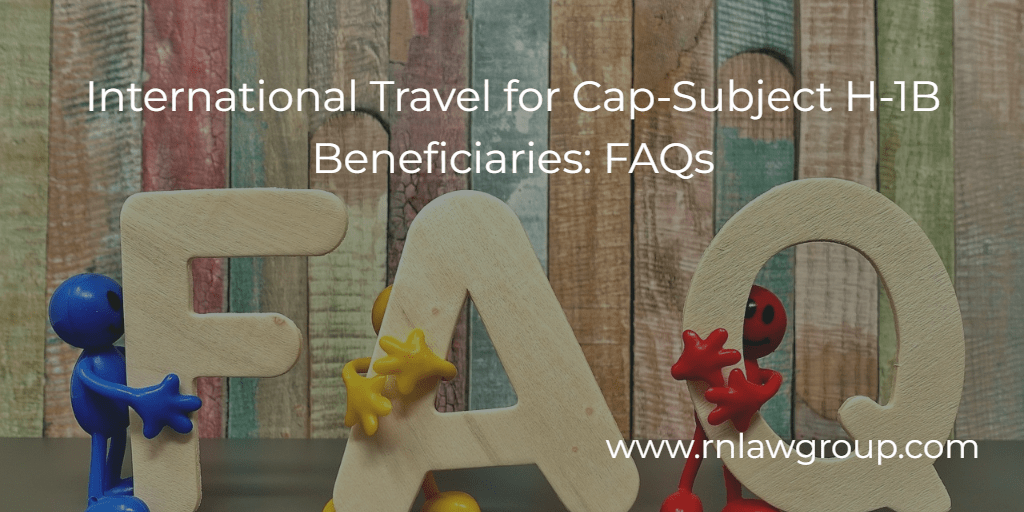
International Travel for Cap-Subject H-1B Beneficiaries: FAQs
For those fortunate enough to have been selected in the recent H-1B lottery, your petition should have been filed by your employer at some point between April 1 and June 30. Cap-subject H-1B petitions involve particular timing, due to the filing deadlines and the fact that even after approval, the earliest that the H-1B status can take effect is October 1 (the start of the government’s fiscal year). Plans for international travel by the prospective H-1B employee during this period therefore should be carefully considered in order to avoid problems at re-entry, or inadvertently voiding the change of status.
Can I travel while the H-1B petition is pending?
Yes, but doing so will require the additional step of consular processing in order to activate the H-1B status later. If the I-129 form requested a change of status, then departing the U.S. while it is pending is considered abandonment of the application, and the “change of status” portion of the petition will be automatically denied by USCIS. Even if the change of status is denied, the rest of the petition, which requests your classification as an H-1B worker, can still continue processing, and if approved, would result in an I-797 Approval Notice that does not include the I-94 attachment. Similarly, if the I-129 form requests consular processing instead of a change of status, the approved petition would result in an I-797 Approval Notice without the I-94.
In both scenarios (an abandoned change of status or consular processing), even if the H-1B beneficiary returns to the U.S. by October, their status would not automatically change to H-1B on October 1. Activating the H-1B status would require traveling to a U.S. consulate abroad, applying for and receiving the H-1B visa stamp, and re-entering the United States with the visa stamp and approval notice in H-1B status. Or, the change of status may also be carried out without travel if the same employer files another H-1B petition requesting the change, which would require re-submission of the application documents and fees.
For applicants who will have difficulty scheduling an H-1B visa appointment within the desired timeframe, or whose employers will not file a second application, it may therefore be best to avoid travel this summer, and to have the petition filed requesting a change of status so that the H-1B employment will go into effect automatically on October 1.
Another consideration for travel during this period is whether the beneficiary will encounter difficulty re-entering the U.S. before October 1 in their current nonimmigrant status. For applicants who are currently in F-1 status, for example, even if their F-1 visa stamp is unexpired, CBP may question whether it is the appropriate status for their admission when the applicant has completed their degree program and is entering with the intention to work full-time.
Can I travel after the H-1B petition is approved and re-enter the U.S. in my current status before October 1?
Yes, but it may result in an I-94 “mismatch” that could require another trip to fix. If your H-1B application has been approved with the change of status request (with the I-94 card attached to the approval notice), then travel afterward would not result in the abandonment described above (please note that you may still face increased questioning at the border when trying to re-enter in your current status, as described above). However, if you successfully re-enter the U.S. in your current status, you will receive a new I-94 record from CBP, which will not match the I-94 number on your I-797 Approval Notice. The change of status would still go into effect as long as you are physically in the U.S. on October 1, but the mismatched I-94 numbers could cause difficulty for driver’s license renewals or social security number applications, as the government’s SAVE system uses I-94 numbers from entry for verification purposes.
The mismatch could be cured by another trip outside the U.S. after October 1 and re-entering in H-1B status, after which the H-1B I-94 you are issued at re-entry supersedes any prior I-94s. Such a trip could also potentially be done without applying for an H-1B visa stamp through the consulate by traveling to Canada or Mexico for less than 30 days and using CBP’s automatic revalidation policy to return.
Can I travel after October 1?
If the H-1B petition has been approved, the beneficiary has not travelled since it was filed, and the change of status goes into effect on October 1, then travel afterwards will not affect the application or status. The beneficiary will need to apply for an H-1B visa stamp from the consulate before returning to the U.S., as their prior visa status is no longer in effect.
What if I am eligible for the cap-gap extension?
For beneficiaries currently in F-1 status whose OPT work authorization expires before October 1, the timely filing of the H-1B change of status petition before the EAD expiration date results in an automatic extension of their OPT work authorization to September 30, known as the “cap-gap” extension. Departing the U.S. at any point prior to October 1, whether the H-1B petition is approved or not, voids the cap-gap extension and the beneficiary would be unable to return to the U.S. in F-1 status. Applicants in this situation would need to plan on remaining outside the U.S., applying for the H-1B visa stamp from a consulate abroad, and then returning to the U.S. in H-1B status in October.
Traveling internationally prior to October can therefore have significant consequences on the H-1B beneficiary’s status and the timing of their return. Cap-subject H-1B beneficiaries should make their employers and/or attorney aware of any prospective international travel prior to the petition being filed, so that appropriate preparations can be made in advance.
By: Rebecca Chen
Rebecca Chen is a Partner at Reddy & Neumann. Her representation includes advising clients throughout the non-immigrant and immigrant visa application process, from initial filing, responding to various requests for evidence, and processing at overseas consulates. Her years of experience in the immigration field have made her a knowledgeable resource for complex business immigration matters.

